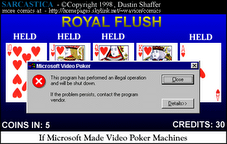A short recap will do for our purposes here at this point, but you should read the entire post. It's fairly short (much shorter than any of mine).
January 23rd, 2007
Rewriting Vista history
Posted by Mary Jo Foley @ 12:08 pm
What would have happened, on that fateful day of August 27, 2004, if Microsoft officials had said: "You know what? We messed up with Longhorn. And we're starting over." Instead, as Microsoft historians know, Microsoft decided to cast its decision to gut the next version of Windows client as a "reset."
"We didn't do much — just took out WinFS, the Windows File System. Oh yeah — and back-port some of the stuff that was supposed to be exclusive to Longhorn to Windows XP. Other than that, it's full-steam ahead."
As Microsoft enthusiast Robert McLaws on Windows-Now.com notes, the Longhorn reset was really more of a do-over.
The Longhorn we first heard about as early as 2002 is not the Vista that Microsoft will launch next week on January 29. Fewer of the application-programming interfaces at its core are "managed," as opposed to "native," than Microsoft originally had hoped/expected. The integrated search is less capable and game-changing than the one Microsoft initially touted. In short, the product formerly code-named Longhorn is more evolutionary than revolutionary.
Like McLaws, I am not criticizing Microsoft for changing its course. I agree with him that the big mistake was not coming clean and admitting that Longhorn, as originally outlined, wasn't going to work. The stuff we saw at the Professional Developers Conference in 2003, which was Longhorn's first coming out party, looked snazzy. But Microsoft couldn't pull it off.
Comments are always an excellent source of perspective, especially when the commenter actually knows some things rather than the "crappy journalism" slams by people who have nothing to say in return.
This excerpt from Not mere hype
Posted by: Mark Miller Posted on: 01/24/07
Even when Longhorn was first announced, the only things that seemed revolutionary to me were WinFS and what was called "Monad" at the time, now called "PowerShell". WinFS was looking like a real technology. I saw a demo of it, and was impressed by it. It's too bad it's being relegated to SQL Server. It seems to me it was one of those cases where MS snatched defeat from the jaws of victory.
Perspective is always nice and always useful. We can then zero in on explanations on WinFS and PowerShell (Monad) to cut to the heart of the subject for education.
Additional: PowerShell Quick Reference
http://www.oreilly.com/catalog/windowspowershell/
And why do I include Monad aka Powershell? I think it may be proven VCSY's Emily is the scripted dynamic language that knocked Bill Gates off his seat when he exclaimed Microsoft needed a dynamic scripted language back in the early days... X# was what it was called. X# (I call it "expound") died the death somewhere between the developers and lawyers but parts of it survive embedded in .Net.
http://www.25hoursaday.com/weblog/default.aspx?date=2006-10-18
Referenciing X#:
Speculation about Microsoft's mysterious X# [April 10, 2003, 14:57]

Color me Galactic






No comments:
Post a Comment